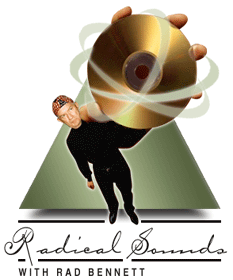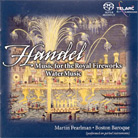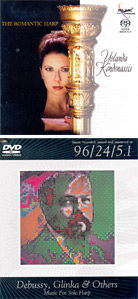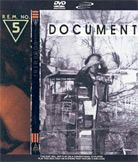 |
| April 1, 2003  Radical
Sounds: There’s Gold in Them There Quadraphonic Vaults -- Let’s Mine It! Radical
Sounds: There’s Gold in Them There Quadraphonic Vaults -- Let’s Mine It!
One of the things that will make or break a new audio or video format is availability of good titles. Though there have been a few notable exceptions, the repertory available to potential DVD-Audio and SACD investors has been pretty lame, scarcely exciting enough to cause anyone to go out and buy an SACD- or DVD-A-equipped player. Let’s face it: We are not living in a "golden age" as far as performers go, so new recordings are not necessarily the way to go. There are no Frank Sinatras, Leonard Bernsteins, Peggy Lees, or Beatles around. Some companies have realized this and reissued recordings from the past in advanced-resolution formats, sometimes with no tampering, often with a lot. But the approach has been very hit or miss. Yet, there was a golden age in which multichannel was recorded, and that was the quadraphonic era of the 1970s. Bernstein was alive, some conductors and rock artists who have now become weighty old bores were doing their most exciting work, and engineers were capturing it in the best imaginable quadraphonic sound. That’s left front and right front, left surround and right surround, with no center and no LFE. Though these releases were of the highest quality, from both the artistic and engineering point of view, they were never heard properly because the quad LP delivery systems were so severely limited and flawed. Even quad tape systems were faulty, mostly in their inability to reduce tape hiss. Now, however, these master tapes can be delivered in all their glory through one of the advanced-resolution systems available today, SACD or DVD-A. Just because these are generally thought of as 5.1 systems does not mean that all of the channels must be used. They are quite capable of reproducing quad, or 4.0. That’s exactly what the producers of the PentaTone label have done -- issued some of the best recordings of the 1970s as originally conceived. The Philips catalog has been tapped for the first eight releases, producing discs that have performances from such musicians as Sir Colin David, Sir Neville Marriner, Seiji Ozawa, David Chorzempa, and Alan Civil. All are sessions that got great critical acclaim when released on CD. Now they sound even better. In fact, if I were pressed, I would have to say that this series is the most consistent in an advanced-resolution format at providing excellent sound. Listen to the Beethoven piano concertos, for instance. The listener is placed in row ten, center, and the BBC Symphony Orchestra sounds rich, full, and focused. You sense immediately that you truly do have the best seat in the house. The solo piano enters and what a sound. It is like a magnificent, properly tuned piano! The overall sound is just right. And so it goes, with every release in this series. In the PentaTone notes which list recording dates, locations, and producers, it is interesting to read this statement: "Although the new SACD standard allows for five fully fledged channels, plus a subwoofer channel, a conscious choice was made to release these early recordings in their original four-channel version in this RQR series; the idea behind this being to do justice to the original intention of both artists and recording technicians." How right, how refreshing, how respectful, how cavalierly ignored by almost everyone else. But the proof is in the pudding. The original artists and engineers knew what they were doing. You can hear that on every disc in this distinguished series, and since they are all hybrid discs, you can enjoy the stereo CD layer now, and play the quadraphonic SACD layer later. When you hear these recordings, they really are good enough that they will probably/possibly lure you into purchasing an SACD machine. We need more and there is gold like this in just about every major company’s vault: classical and popular. How about a few mining expeditions! Any takers? Vox, BMG (RCA), EMI (okay this company did produce about ten DVD-As a year and a half-ago, but then it stopped!)? In the meantime, good news: There will be eight more PentaTone Philips releases soon, and probably more in the future. Here is a complete list of the original eight PentaTone releases, every one a winner:
These three (one being a pair) made the cut this month:
There are not very many advanced-resolution discs available at this point in the game, yet many titles have already been duplicated, attesting to their immense popularity. Taking both SACD and DVD-A formats into account, these popular Handel compositions have been triplicated. There is an excellent DVD-A recording on EMI with Sir Charles Mackerras conducting various ensembles, and there’s a less successful, gimmicky recording on Vanguard SACD with Johannes Somary leading the English Chamber Orchestra. The Mackerras must be given serious consideration, since he ably conducts the original outdoor scoring of the Royal Fireworks Music, using a wind band that includes 26 oboes, 14 bassoons, four contra-bassoons, two serpents, nine trumpets, nine horns, and six side drums! Yet Pearlman’s Boston reading holds its own very well, even though he performs the later indoor version of the piece, which reduces the number of winds and adds a string compliment. Pearlman does use one serpent which gives the bass line a nice snarl, and he gets crisp and precise playing from his chamber orchestra. The acoustic is warm and resonant, the recording venue being the Mechanics Hall in Worcester, Massachusetts. The only two performances as exciting as this are Fennell’s on early Telarc (scheduled, I was told, for two-channel SACD sometime in the future) and Sir John Eliot Gardiner’s hell for leather performance on Philips. For the Water Music there is no competition. This is the best one on SACD and one of the best in any format. Lively tempos, appropriate ornamentation, and virtuoso playing make this read a thrilling experience. Without the timpani, side drums, and serpent sounds of the other piece bouncing off the side and back walls of the hall, the acoustic seems a little cleaner, which means that this recording has done an admirable job of conveying a real-life concert experience! I have nothing but the highest praise for this release. It’s Hybrid SACD, too, so you can play it in stereo on your regular CD player. Yet Telarc did another double inventory here (see last month’s column for harsher words on this) and released it on regular CD as well!
The Romantic Harp I have found that recordings of solo instruments often make the best test records. All is exposed, naked audio as it was, with no place to hide. The harp has often sounded good on analog recordings, a little less so on CD. On these two high-resolution recordings, the harp sounds as if it has been transported into your listening room. Talk about realism all you want, but it is impossible to imagine a symphony orchestra actually being in your living room; there simply isn't the space. However, it is realistic to imagine a harpist sitting about ten feet in front of you, and each of these recordings gives that illusion. The Roncea recording is a little more defined, especially the lower register; the Kondonassis sounds somewhat veiled by comparison. The slight difference could be the player, the recording hall, the use of the center-channel speaker (AIX seems to put more confidence in it), or simply my different SACD and DVD-A players. Both discs offer first-rate sound, impeccable playing, and imaginative programming, though only the Telarc has informative notes. The AIX disc’s liner notes do not even have a biography of Ion Ivan Roncea. This is a shame and gross oversight, because he is apparently one of the world’s great harpists. Since one disc is DVD-A and the other SACD, many people will have to make a choice, but given a universal player, I would want both of these discs in my collection. Plucked instruments benefit greatly from advanced-resolution sound. The stereo tracks are clean as can be. The multichannel surround tracks on each recording are used sparingly and do not call attention to themselves. But what presence a discreetly used surround track can add! These two recordings prove it.
This is one of two new EMI releases sent for consideration, and by far the better of the pair. This is a remix of the band’s 1987 album Document -- R.E.M.'s fifth outing. Elliot Scheiner has done the remix for 5.1 and it is a remarkably restrained and effective accomplishment. I don’t know how you feel about it, but I have a big problem with gratuitous surround effects that detract and distract from the music. Here, the solid, well-defined band sound remains rooted up front, with some pan around the sides to amiably expand the front soundstage. The surrounds are generally used for effects or backing vocals and instrumentals. This approach puts the listener into the overall soundfield while still allowing concentration on the main performance. The opening of "Exhuming McCarthy" pans the opening typewriter sound effect around the room but concentrates on the front once the music begins. The final two refrains of "It’s the End of the World As We Know It (and I Feel Fine)" mix in voices to the sides and rear in such an effective way that the result seems like a sing along, as if the person sitting next to you has decided to join in. There are a few lapses from grace, such as a jarring piano glissando from the right rear, but by and large, this is exceptionally satisfying 5.1 sound. In case it is still too much for you, a highly defined, solid-sounding advanced-resolution stereo mix is included. This DVD also contains three excellent music videos, onscreen lyrics that can be synchronized with the music, as well as a gallery of still photos. There are also DTS and Dolby Digital tracks, which make the disc fully backward compatible. ...Rad Bennett
Ultra Audio is part of the SoundStage! Network. |
 Handel: Music for the Royal
Fireworks; Water Music. Boston Baroque; Martin Pearlman, director.
Handel: Music for the Royal
Fireworks; Water Music. Boston Baroque; Martin Pearlman, director.  Music for Solo Harp
Music for Solo Harp R.E.M.: Document
R.E.M.: Document